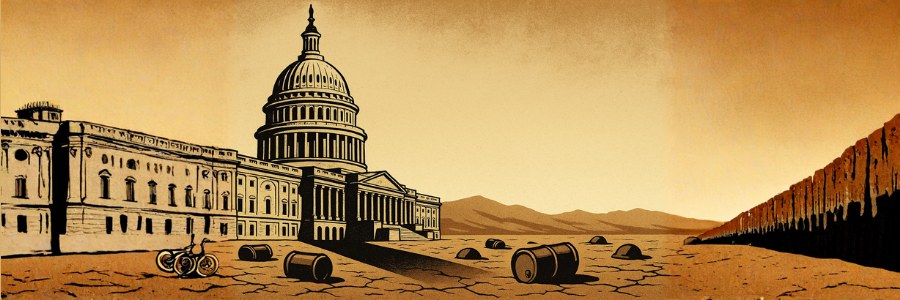
Posted November 10, 2025
By Sean Ring
The Trap China Set For America
When I first started writing about China years ago, I used to joke that Beijing was playing Monopoly while Washington was playing Candy Land.
Now I’m not so sure it’s a joke anymore.
Because what’s happening right now isn’t a trade war, a tariff spat, or a tech rivalry. It’s a clash between two entirely different economic religions — and only one of them still believes in work.
Good friend and Senior Analyst for Strategic Intelligence and Strategic Intelligence Pro, Dan Amoss, and I had a bit of banter on the Paradigm Press Editorial Slack channel that would interest you. We discussed Trump’s options for the U.S. in relation to China. I’ve cut that down into an article that describes the trap China set for America that The Donald is contending with right now.
My thanks go to Dan for his unparalleled ability to peel the story from reams of data.
The New Chinese Model: Overcapacity as a Weapon
While Wall Street obsesses over Sam Altman’s latest AI sermon, Beijing just held one of the most consequential Communist Party plenums in years.
And the takeaway? China’s doubling down on the very model we thought would eventually implode: state-bank-funded, overproducing, margin-crushing manufacturing.
It’s not a bug. It's not even a feature. It’s the plan, an intricate trap America may fall into, and may not return from intact.
China now makes more than half the world’s steel, ships, solar panels, and EV batteries. Every time you think “surely they can’t make more,” they do — and they ship it at rock-bottom prices across the planet.
That’s not economic inefficiency—that’s economic warfare.
Inside China, it’s called “involution.” Factories compete to the death on wafer-thin margins, forcing innovation, consolidation, and endurance. The weak die, the survivors dominate global markets.
And at the latest plenum, the Party was explicit: it will “upgrade traditional industries as well as foster, strengthen and expand emerging and future industries.”
Translation: they’re going to flood the world with even more cheap high-tech goods — from EVs and turbines to semiconductors and solar.
Overcapacity at home. Price destruction abroad. Dominance everywhere.
America’s Dilemma: The Tariff Mirage
So what’s America’s answer? Tariffs, mostly.
Trump revived them. Biden kept some. Trump 2.0 will likely crank them up again.
In theory, tariffs buy time — a chance to rebuild U.S. industry, protect jobs, and regain self-sufficiency.
But time is worthless if you waste it.
You can’t “reindustrialize” if companies think tariffs could vanish after the next election. Why pour billions into a new steel plant when the next guy might trade it away for soybean exports and a handshake photo op?
The truth is, no company can plan 20 years ahead in a country that changes its industrial policy every four years.
And here’s the deeper contradiction:
Do we want easy money and soaring stock markets?
Or do we want hard work and real industry?
Because you can’t have both forever.
Silicon Valley, Wall Street, and the “laptop class” want low rates and endless liquidity. The Rust Belt needs tighter conditions, higher rates, and capital redirected into factories instead of apps.
That’s the real civil war — not North vs. South, but Tech Coasts vs. Steel Belt.
The End of the Free-Trade Fantasy
For decades, America’s ruling class worshipped at the altar of “free trade.”
The theory was simple: ship your factories overseas, buy the goods back at a lower cost, and live off your 401(k).
It worked beautifully… until it didn’t.
China took our supply chains, our know-how, and our market access — and used them to build an economic empire.
Meanwhile, we built what Dan calls a “Russian nesting doll of promises backed by promises.”
Stocks backed by debt. Debt backed by faith. Faith backed by the Fed.
We don’t make enough real things anymore. We just trade claims on the future.
And now those claims are piling up — IOUs, pensions, bond coupons — faster than the real economy can produce the goods to honor them.
That’s not capitalism. That’s Ponzi-ism.
The Re-Shoring Mirage
“Bring it home!” sounds great on a campaign poster.
But here’s the reality: real reshoring is deflationary, not inflationary.
Wait, what?
Yes — deflationary. Because rebuilding factories means cutting corporate margins, reducing stock prices, and redirecting capital into long-term physical investments rather than short-term financial speculation.
When companies pay higher wages and buy more equipment, they either:
- Earn less profit (bad for shareholders),
- Raise prices (bad for consumers), or
- Cut costs elsewhere (bad for workers).
Any way you slice it, the stock market doesn’t like it.
So when pundits say “reindustrialization will drive inflation,” they’re missing the point. Inflation’s only a problem if you keep papering over weak productivity with money printing. Real industry would actually discipline that impulse.
But it also means asset prices would fall, at least for a while. And politically, that’s toxic.
Boomers don’t want to hear “Nasdaq 10,000 for the greater good.”
They want their portfolios to go up forever.
The Social Contract Cracks
Here’s where it gets ugly.
If America truly reversed 40 years of offshoring, everything would have to be rewritten — debt contracts, retirement expectations, even the Fed’s playbook.
QE wouldn’t be a “stimulus.” It would be a stopgap.
And if those famous “SPX 10% annual returns to infinity” disappear for a decade or two, then the whole retirement-industrial complex — pensions, insurance, wealth management — gets turned upside down.
That’s why politicians won’t touch it.
They promise both “strong markets forever” and “a rebuilt Rust Belt.”
That’s not a policy. That’s astrology.
Three Roads Ahead
At this point, America has three choices — and none of them are painless.
1. Stay the Course
Keep rates low, let financial markets rule, and hope Silicon Valley’s magic offsets the impact of Chinese steel and solar.
Sure, we’ll keep “selling paper claims” to the world — bonds, stocks, dollar debt — but we’ll stay rich on spreadsheets.
Until the spreadsheets stop working.
When the system eventually buckles, expect political fury: confiscatory taxes, capital controls, “patriotic” wealth redistribution, and maybe a Universal Basic Income to calm the mob.
2. The Hard Reset
Tell the truth. Rebuilding industry means pain — lower asset prices, higher costs, and a generation of adjustment.
It’s like a wartime economy without the war.
But if done right, we could rebuild genuine productive capacity — mines, mills, fabs, shipyards — instead of apps that spy on your data and sell ads to each other.
The risk: markets revolt before the public rallies.
3. Muddle Through
The path we’re on. Talk tough on China. Impose tariffs. Then print money to offset the pain.
Pretend we’re reshoring while the Fed props up the markets.
The worst of all worlds: no new industry, no reform, no credibility.
Choose, or Be Chosen For
The next decade won’t be defined by who’s president. It’ll be determined by whether America decides what kind of economy it actually wants to be.
A financialized casino trading claims on a shrinking industrial base?
Or a production powerhouse willing to sacrifice paper wealth for real strength?
Beijing made its choice. It’s building things — fast, dirty, and disciplined.
Washington keeps trying to have it both ways.
But history’s ruthless about indecision.
As Dan put it best: “Better to act with purpose and vision than to always be reacting.”
And he’s right. Because failing to choose is still a choice — one that ends with China making the world’s goods, and America selling IOUs to buy them back.
Wrap Up
The world’s entering an Age of Overcapacity — and China’s mastered it.
America’s trapped in an Age of Overpromising — and it’s running out of time.
The bill for four decades of offshoring, easy money, and financial self-delusion is finally coming due.
And the longer we delay, the higher the interest rate on reality.

This Edition Belongs to You
Posted November 14, 2025
By Sean Ring

An Open Letter to President Trump
Posted November 13, 2025
By Sean Ring

Charlie Munger’s Wit and Wisdom
Posted November 12, 2025
By Sean Ring

The Lakes of Storm and Steel
Posted November 07, 2025
By Byron King

The Start of the Metals Rebound?
Posted November 06, 2025
By Sean Ring

